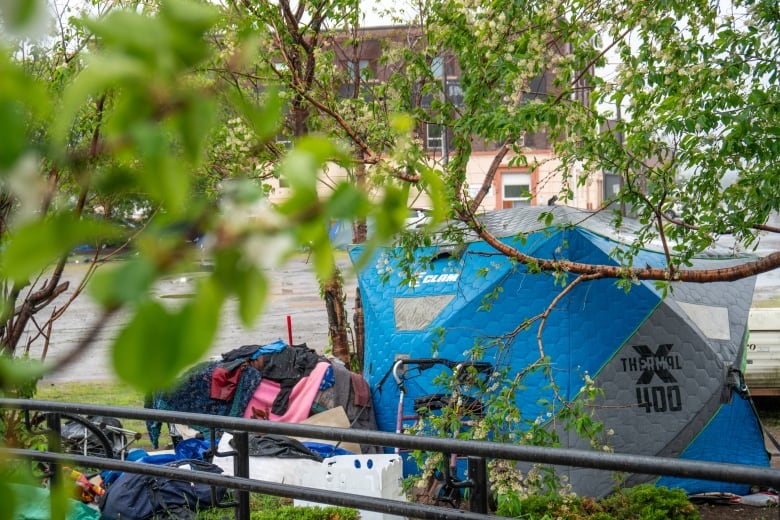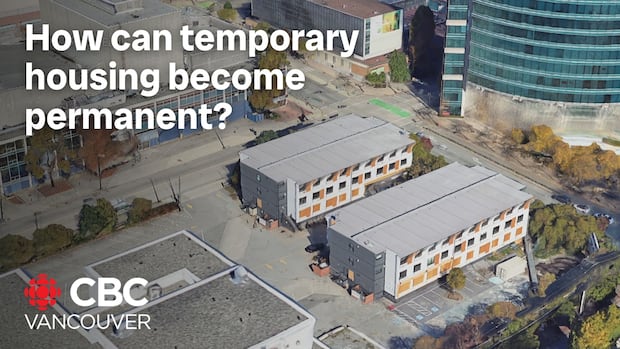
Erland Missewace says if the City of Thunder Bay, Ont., goes forward with creating a temporary village for the unhoused population, he would finally get a sense of safety.
City council approved a new 10-step plan earlier this week to respond to the growing number of people in encampments, which peaked at about 200 this summer.
Part of the plan includes the possible creation of a temporary village, a concept that’s seen success in other Canadian communities. Under Thunder Bay’s plan, there may be up to 100 units where people would have access to hygiene facilities and on-site support.
Missewace, who’s been without a permanent home for three years, is a member of Eabametoong First Nation and grew up in Thunder Bay. He used to live in an encampment and is now sleeping at an overnight shelter.
During the day, he goes to People Advocating for Change Through Empowerment (PACE), which operates a drop-in centre on the city’s south side.
“The cost of living is crazy. On Ontario Works, we only get $400 for rent and a one-bedroom apartment is like $1,000 plus,” Missewace said. “It’s insane.”
The plan’s approval comes the same week Ontario’s big-city mayors, including Thunder Bay’s Ken Boshcoff, called for more action from the provincial and federal governments to address homelessness, mental health and addictions.
Thunder Bay is considering two potential sites for a temporary village, both of them in the south end: 114 Miles St. E. and Kam River Heritage Park. The goal is to cap construction and infrastructure costs at $5 million for the project and operating costs at $1.5 million annually.
“Just having a place to stay, just having somewhere to call home, I think that would be enough,” Missewace said of the temporary village. “That sounds like a great idea.”
Giving people stability, on-site support
There were at least 1,400 homeless encampments across the province last year, according to the Association of Municipalities of Ontario (AMO).
Encampments involve people sleeping in tents; a temporary village offers a more structured environment with wraparound services, and gives people a permanent address, noted Rilee Willianen, drug strategy specialist with the City of Thunder Bay.
Other communities in Ontario have seen success with this model, including Kitchener’s A Better Tent City and Peterborough’s Modular Bridge Housing Community. In Vancouver, there’s also a similar concept known as modular supportive housing.
Temporary modular housing plays an important role in addressing homelessness in Vancouver. But what happens when it’s torn down to make room for development? Caroline Chan learned more about the advantages and challenges of making temporary modular housing permanent.
Thunder Bay is considering a sleeping cabin model. While city council has supported the village in concept through the 10-step plan, it’s still pending final approval.
“The village is really meant to be an interim stopgap in between getting off the street and into a more stable housing option, to get people in a place where they’re stabilized and going to be successful,” Willianen said.
The city’s goal is to set up the village by the end of April, when people transition from indoor winter shelters to sleeping outside.

“It’s a lot harder to get folks once they’re established already with their setup — they’ve made their living area outside,” she said.
Willanen admits the timeline is “aggressive,” but stressed the community’s homeless population needs an interim solution while more long-term transitional housing units are being constructed.
Members of the public are being encouraged to complete a survey, available until Oct. 31, about where they think the temporary village should be built.
“We’re not looking at this only from the angle of what’s best for people experiencing homelessness — we’re looking at this also from the angle of what’s best for the people that live in the area, the people that work in the area,” Willianen said.
‘They are just in survival mode’
Another feature of Thunder Bay’s 10-step plan is the creation of a committee including people with lived or living experience of homelessness to inform the city’s strategy going forward.
“We know that those people who are living in tents on the streets have the most expertise when it comes to things that will help make their lives better,” Willianen said.
CBC News spoke with several people at PACE who have lived experience of homelessness to hear their thoughts on the temporary village.
“I think that’s fantastic and I think that should have been done sooner,” said Lorri-Lyn Walker, PACE membership co-ordinator.
Walker was homeless for eight months when she was in active addiction. She is now seven years into her recovery and uses her role at PACE to help others connect to community resources.
In her view, the temporary village should be led by peer support workers who can provide on-site assistance.
Bradley Prince, who is staying in an overnight shelter in Thunder Bay, is three months into his sobriety. He said PACE workers, who all have lived experience of the challenges their clients are going through, have helped him stay on track with his goals. This week, he started a new job.
“The main thing I think that we all need is people like Lorri who’s been helping me and people who have came from a past, but have came out of that past with much knowledge to support the people around them,” Prince said.
Robert Dennhardt, a PACE client who was formerly homeless, said the village is a great idea and it reminds him of tiny home projects he’s seen on the East Coast.
For her part, Hazel Cripps, who abandoned her apartment due to an incident that made her feel unsafe, said she’d rather see the city convert empty buildings into housing units rather than spend money on temporary shelters.
Everyone at PACE agreed any approach to homelessness must be led with compassion.
“Our clients are harmless. The people living at the tents, they’re harmless — they are just in survival mode,” said Walker.
“If people from council took the time to go down and actually speak with them and hear their stories, not just assume they’re homeless or drug addicts — they don’t know what happened to them the night before.”
Sleeping cabins versus tiny homes
Carrie Anne Marshall is an associate professor in the school of occupational therapy at at London’s Western University and director of the social justice in mental health research lab.
She has researched on the rise of tiny home and sleeping cabin communities across North America, and said it’s important to distinguish between the two.
“For me, a tiny home is a self-contained unit that includes all of the amenities that we would typically expect in a regular home. It’s just smaller,” said Marshall. “Sleeping cabins, to me, are often 8-by-10 [foot] structures that do not have the amenities of a regular home.”

While tiny homes have been proven to give people a sense of security and belonging, “we have no evidence to compare sleeping cabin communities with shelter spaces to tell whether one is better than the other.
“I think if community advocates are trying to find solutions in the absence of other resources and want to help people just stay warm, I think that’s really a beautiful kind of strategy to help people in the short term,” Marshall said of the temporary village concept.
“Where I become more and more concerned is where we’re using public dollars that could be dedicated to increasing the capacity of shelter spaces or permanent supportive housing programs” for “a temporary system that has little evidence to support it.”
In Thunder Bay’s case, Willianen said, the city is paying attention to what other communities are doing to address homelessness in the most thoughtful, effective way, taking into account people who are “living unsheltered” and the broader community.
“It’s to give them the ability of the tools and skills to move on to something that will support them throughout their life and not just in this crisis moment.”
